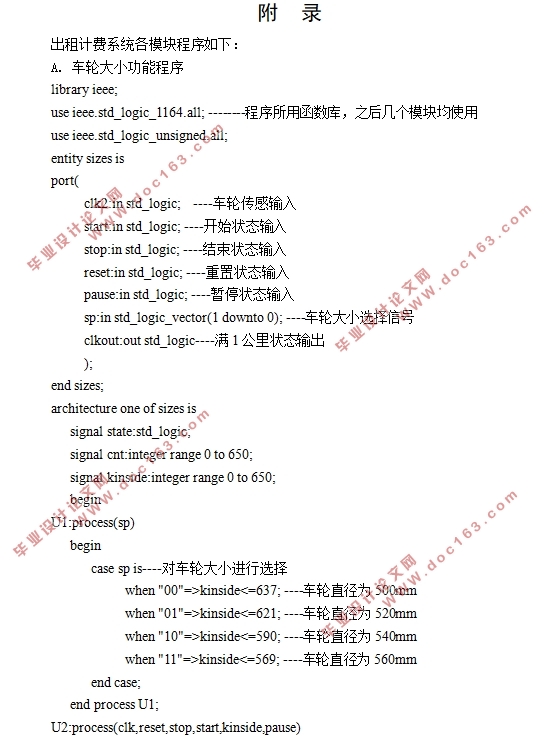出租车计费系统的FPGA设计

出租车计费系统的FPGA设计(任务书,开题报告,外文翻译,论文13000字)
摘 要
传统的出租车计费系统采用单片机进行设计,其硬件构成电路较复杂且程序语言并不通用,因此,系统的功能调节或升级极其不便。针对以上所述情况,依靠日益发展的EDA技术,科学家可以基于FPGA进行设计研发出满足当前人们需求的出租车计费系统。充分利用FPGA的低成本及可编程性,使出租车计费系统升级调节更简易,且载体更低廉轻便。该设计采用自顶向下的设计方法,构造了包含车轮大小选择模在内七个子模块的功能,并通过连接它们构成系统,最终系统实现选择车型模式,计费计程,实时显示的功能。出租计费系统基于Altera公司的Cyclone II系列芯片EP2C700F896C8,使用VHDL语言进行编程,并通过Quartus II软件平台实现仿真编译。最终实验设计成功,该系统完成所需设计功能,且操作简单,成本低廉。
关键词:出租车;计费系统;FPGA;VHDL;Quartus II
Abstract
The traditional taxi billing system is designed by microcontrollers. The hardware circuit of MCU is complex, and the program language of MCU is not universal. So the function adjustment or upgrade of the system is extremely inconvenient. In view of the above situation, relying on the increasingly developed EDA technology, scientists can base the FPGA to design and develop the current mass demand for taxi billing system. making full use of the FPGA which is low cost and programmable, it makes the taxi billing system upgrade and adjustment more simple, and the carrier is cheaper and lighter. The design adopts a top-down design method, Constructed the function of seven sub-modules including wheel size selection mode. And use seven modules to form a system, finally the system realizes the function of selecting the model mode, billing and real-time display. The system is based on Cyclone II series chip EP2C700F896C8 of Altera company. and it is designed with VHDL Language, and is emulated on the Quartus II software platform. The final experimental design was successful, the system completed the required design functions, and the operation was simple and the cost was low. [资料来源:www.doc163.com]
Key Words:The taxi. Billing system; FPGA; VHDL;Quartus II
本文主要内容
本设计根据当前出租计费系统所面临的挑战,所采取的措施为:以FPGA器件替换微处理器,这将减少设计时间及工作量,同时提升设计整体的稳定性,并减少PCB板的面积;新增车轮选择功能,覆盖大部分车型,扩大系统的适用范围;实现计价规则的制定可调化,减少因物价波动需对系统调节的时间,优化出租车司机与系统的交互体验;实时显示出租车状态信息,保证费用结果公正。
由此,本文总共分为四章。第一章主要提到了关于出租计费系统设计这个课题的背景,当前课题现状和未来趋势以及本次设计的主要工作。第二章先对设计所涉及到电子设计自动化及其相关的知识进行介绍,再提出了系统的设计思路及方案,并详细阐述系统的七个子模块各自的功能。第三章对Quartus II软件进行介绍,对各子模块的程序代码进行仿真,分析各自仿真结果;将各子模块结合后进行整体仿真,并分析结果。第四章将总结本次设计,对出租车计费系统的未来做出展望。
[来源:http://Doc163.com]


目 录
第1章 绪论 1
1.1 课题背景 1
1.2 出租车计费系统的现状及趋势 2
1.3 本文主要内容 2
第2章 出租车计费系统设计 4
2.1 EDA技术介绍 4
2.2 FPGA器件介绍 4
2.3 VHDL语言简介 5
2.4 系统设计思路 6
2.5 系统程序设计 8
2.5.1 车轮大小选择模块设计 8
2.5.2 计程模块设计 8
2.5.3 计时模块设计 9
[来源:http://www.doc163.com]
2.5.4 计费模块设计 9
2.5.5 数据分配模块设计 10
2.5.6 分频模块设计 10
2.5.7 显示译码模块设计 11
2.5.8 系统顶层原理图 11
第3章 系统的仿真与分析 12
3.1 Quartus II软件介绍 12
3.2 系统子模块仿真 12
3.2.1 车轮大小选择模块仿真 12
3.2.2 计程模块仿真 14
3.2.3 计时模块仿真 14
3.2.4 计费模块仿真 15
3.2.5 数据分配模块仿真 16
3.2.6 分频模块仿真 17
3.2.7 显示译码模块仿真 17
3.3 总体电路仿真模块设计 18
第4章 总结与展望 21
4.1 总结及体会 21
4.2 展望 222
附 录 24
致 谢 34 [资料来源:https://www.doc163.com]
